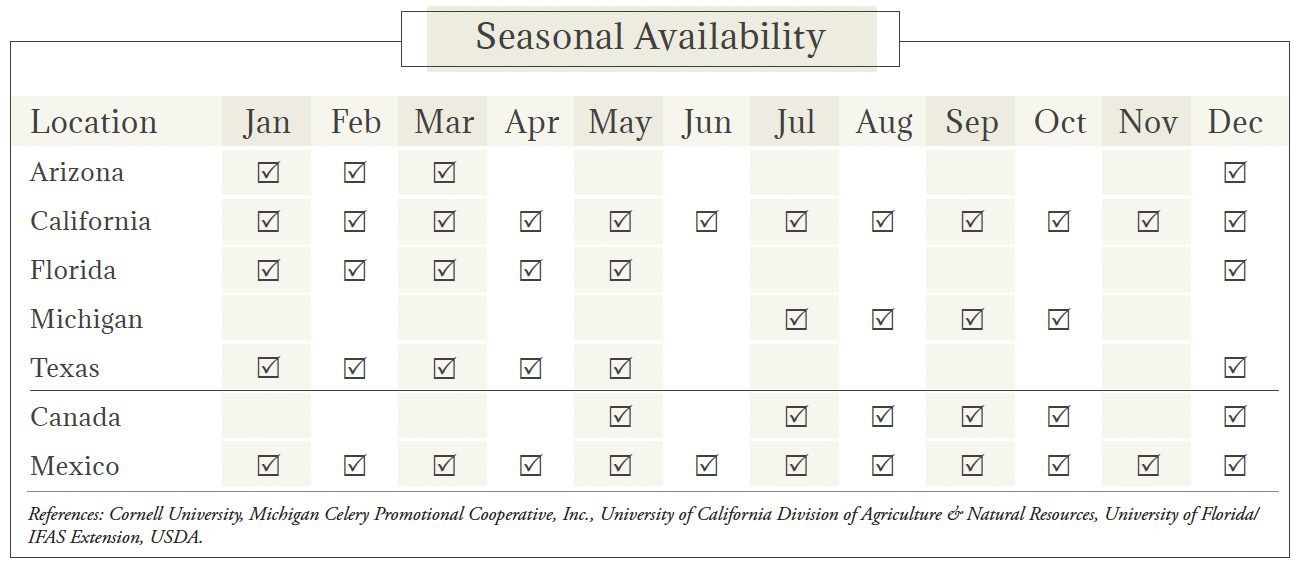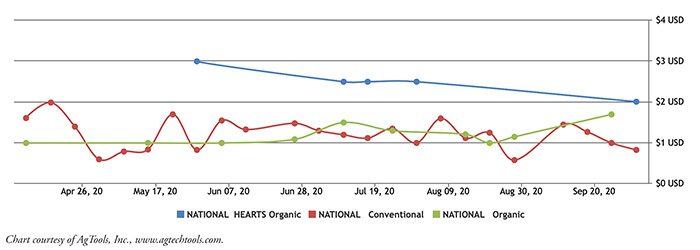Welcome to Blue Book!
Are you ready to join the thousands of companies who rely on Blue Book to drive smarter decisions? View our plans and get started today!
Still have questions? We’d love to show you what Blue Book can do for you. Drop us a line– we’ve been waiting for you.

In this article
Image: Alfredo Maiquez/Shutterstock.com
Celery Market Overview
Celery, Apium graveolens, is a member of the Apiaceae family with carrots, cilantro, and parsley, and likely originated in the Mediterranean basin. It was reportedly brought to the United States in the mid-1800s.
Domestically, California leads production, though Michigan is often credited with having the first commercial production. Michigan is still a notable producer, along with Texas, Arizona, and Florida. Celery exports consistently outpace imports; both Canada and Asia are top destination markets.
Types & Varieties of Celery
Celery’s leafy stalks (petioles) can grow up to 24 inches. The green, long-stalked variety (also called ‘Pascal’) can come in blanched white or red coloring and is the most common, though celeriac (celery root) and leaf celery are also popular.
Typically only the stalks are eaten, but roots and leaves can be consumed as well. For celeriac, although similar looking to celery, only the tuberous base or root is eaten.
Long-stalk varieties include Conquistador, Giant Pascal, Golden, Redventure, Tall Utah, Tango Green, and Ventura; celeriac types include Brilliant, Diament, Large Smooth Prague, Mentor, and Tellus; for celery leaf, there’s Par-Cel and Safir.
The Cultivation of Celery
Celery is a cool season crop, sensitive to any temperature extremes. It is typically seeded 8 to 10 weeks before transplant into nutrient-rich soil. Transplants should have a few leaves and well-developed roots.
Once transplanted, celery should not be exposed to temperatures below 50°F to prevent bolting. Row covers can be used to protect from frost.
During harvest, a sharp blade will minimize abrasions, other types of damage, and decay. Celery should be stacked carefully to prevent injury.
Pests & Diseases Affecting Celery
Leafminers will lay eggs on celery and larvae create ‘winding mines’ through plants. Cabbage loopers lay eggs on leaves and larvae leave ragged, large holes when feeding. Other common pests include aphids, armyworms, beetles, cabbage worms, mites, carrot weevils, and whiteflies.
Anthracnose-leaf curl, a more recent introduction to U.S. crops, curls leaves and causes discoloration and lesions. Clearing debris can help limit the spread. Leaf blight emerges as isolated spots on leaves that turn into lesions.
Blackheart is a calcium and moisture deficiency that leads to discoloration and leaf death. Mosaic viruses, various types of rot (watery, basal stalk, pink, bacterial soft rot, etc.), fusarium, grey mold, rot knot, wilt, and powdery mildew can all also affect celery.
Storage & Packaging of Celery
Celery should be cooled (forced air, hydrocooled, or vacuum cooled) immediately after harvest to 32 and 36°F with high relative humidity.
At cold temperatures, freezing injury can lead to flabby, water-soaked leaves and stalks. Freezing injury may also cause lesions on the stalk, which will turn brown.
Like asparagus, celery continues to grow after harvest: extra horizontal space should be allowed in boxes or crates.
References: Cornell University, New England Vegetable Management Guide, North Carolina State University Extension, University of California Vegetable Research & Information Center, USDA.
Grades & Good Arrival of Celery
Celery is divided into U.S. Extra No. 1, U.S. No. 1, and U.S. No. 2 grades.
Generally speaking, the percentage of defects shown on a timely government inspection certificate should not exceed the percentage of allowable defects, provided: (1) transportation conditions were normal; (2) the USDA or CFIA inspection was timely; and (3) the entire lot was inspected.
| U.S. Grade Standards | Days Since Shipment | % of Defects Allowed | Optimum Transit Temp. (F) |
| 10-2 | 5 4 3 2 1 |
15-4 14-4 13-3 11-2 10-2 |
32° |
Canadian good arrival guidelines (unless otherwise noted) are broken down into five parts as follows: maximum percentage of defects, maximum percentage of permanent defects, maximum percentage for any single permanent defect, maximum percentage for any single condition defect, and maximum for decay. Canadian destination guidelines are 15-10-5-10-4.
References: DRC, PACA, USDA.










